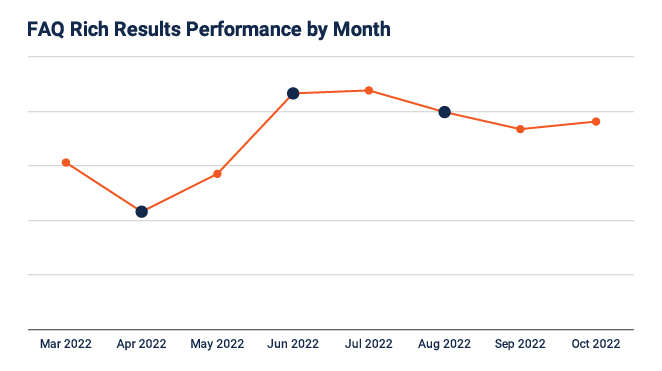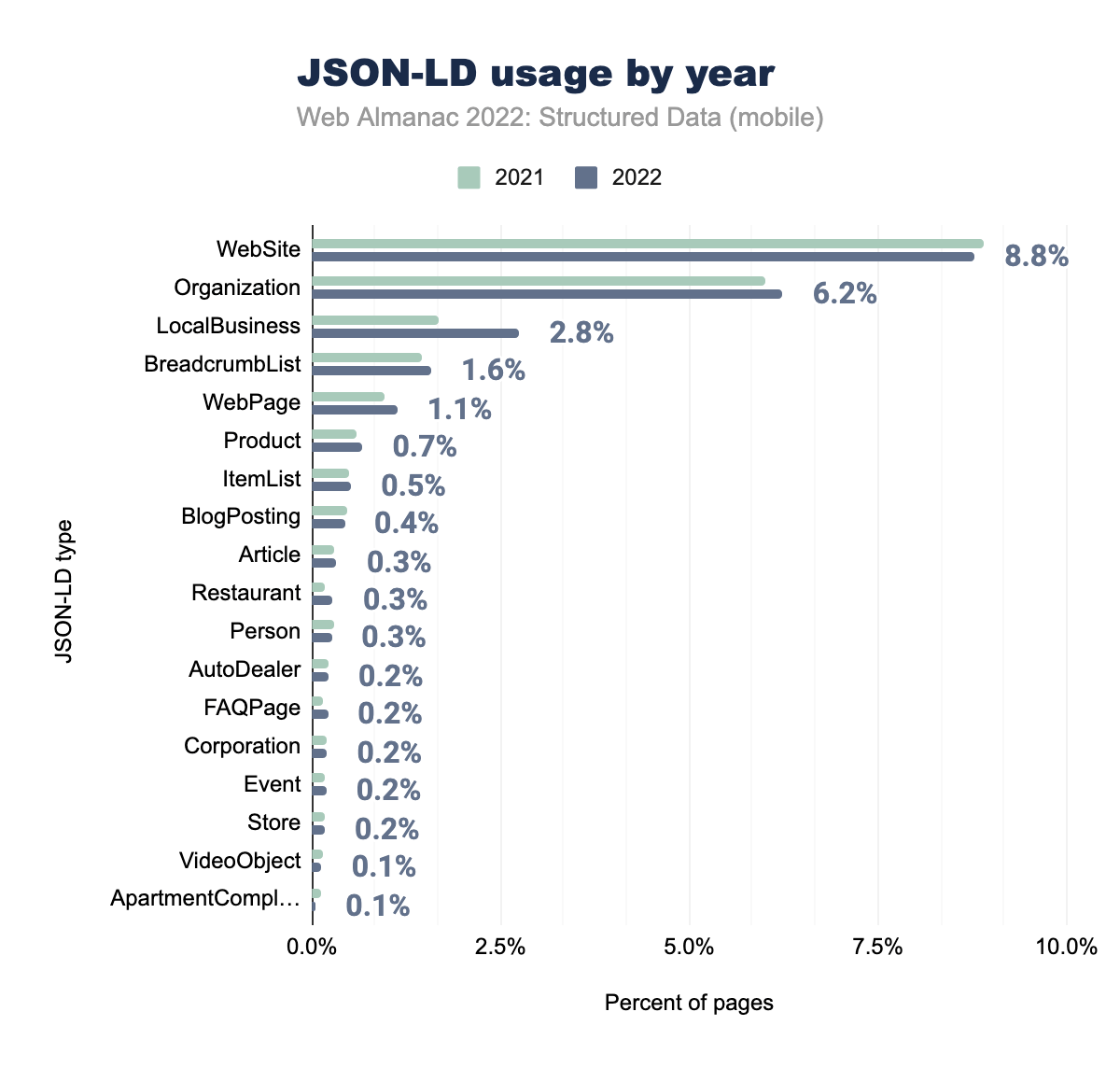
2022 was an eventful year in the world of Schema Markup and Rich Results. As Google continues to improve the search experience for users, we’ve seen volatility in rich result performance, changes in search appearances and new Structured Data properties for existing rich results.
At Schema App, our Customer Success Team is constantly navigating and pivoting through these changes to help our customers maintain and grow their visibility in search. As such, we’ve gathered some key insights from our team on their learnings from 2022 and what they expect to see for Schema Markup in 2023.
Insight #1. Google is investing a lot in Structured Data
In 2020, Google invested heavily in COVID-related Structured Data changes. In 2021, things were quieter and we saw fewer activities.
This year, Google introduced significant updates to their Structured Data documentation and 2023 is likely to maintain the same momentum.
Machine learning complements Structured Data
In April 2022, Google released an episode on their Search off the Record Podcast called “Structured Data: What’s it all about?”.
In the episode, Ryan Levering shared how Google uses Structured Data to complement their machine-learning work. Structured Data is currently provided by users to help Google understand the content on a page and improve the accuracy of its search results. Levering has emphasized that “it’s always good to empower people who are giving you data, to have control over that.” Rather than rendering Structured Data obsolete, machine learning will fill the information gaps or “enhance coverage of the feature” on Google search.
According to Levering, Google will also “…continue to flesh out the Structured Data usage in terms of adding more features and looking into more ways [they] can use it in cooler things that are not just visual treatments but actually help with more understanding on the page”. This is reflected in the changes we saw in 2022 and foreshadows what is to come in the new year.
Notable changes from Google in 2022
Changes in Video rich results
In June 2022, we observed a decrease in clicks and impressions for Video Rich Results on desktop. This trend was also noticed by other SEOs. At the same time, we noticed a change in how the Video Rich Results were being presented on the SERPs.

Data provided by Schema App / Schema Performance Analytics
The Video Rich Results showing up on the ‘All’ search results page only featured Youtube videos. Upon clicking on these results, users would be directed to the video’s Youtube page rather than the site where the video was embedded. Learn more about the changes in Video rich results here.
Volatility in FAQ rich results
In April 2022, 65% of our clients experienced a drop in clicks on their FAQ rich results and saw their results recover again in May. This happened again in August 2022, only for the results to recover again in late October.

Data provided by Schema App / Schema Performance Analytics
Despite the disruptiveness of these fluctuations, you should not “abandon certain rich result targeting should performance start to drop”, says Kevin Veilleux, a Customer Success Manager at Schema App.
“As we saw with Videos and FAQ, there’s value in staying the course”.
Major developments in Product search results
This past year, Google also made waves in Product search. Google is enabling more Products to be shown on the SERP, which comes as no surprise as their competition with Amazon heats up in the eCommerce space.
Expanding eligibility for Merchant Listing Experiences with Product Structured Data
In September 2022, Google announced that businesses can now be eligible for Merchant Listing Experiences by adding Product Structured Data to their web pages. At the same time, they added more recommended Product Structured Data properties such as colours, size, and material for merchant listings.
New Merchant Listings report on Google Search Console
On top of expanding the eligibility for Merchant Listing Experiences with Product Structured Data, Google also introduced a new Merchant Listing Report on GSC. This new report will help merchants identify Structured Data errors, warnings and valid pages for free listing experiences in search.
New Pros and Cons enhancement for editorial Product review pages
Product reviews are a helpful resource in the buyer journey and Google added a new ‘Pros and Cons’ enhancement to the product review snippets. Businesses can add Pros and Cons Structured Data on their pages with product reviews to be eligible for this new enhancement.
2022 was a busy year for Structured Data and we see this as a signal of its growing importance in Google’s search environment. What does this mean for SEO teams in 2023? It means, it’s time for SEO teams to start prioritizing Structured Data as part of their SEO strategy.
Insight #2. Invest in your SEO Structured Data strategy as soon as possible to stay ahead of the competition
According to research by the HTTP Archive, the usage of Structured Data has increased in 2022, in comparison to 2021. Of the websites they surveyed, they found that the use of JSON-LD on homepages increased from 34% in 2021 to 37% in 2022 on mobile devices. This upward trend of Structured Data usage reflects the growing popularity of Structured Data as an SEO strategy, and we predict this trend to continue in 2023.
The HTTP Archive’s research also showed that WebSite, Organization and Local Business were three of the most used Schema.org types in 2022. Even though more sites are implementing Structured Data, many of them are implementing it on a basic level. Image by HTTP Archive
Image by HTTP Archive
Google has over 32 rich result opportunities and there are many other types of Structured Data that have yet to be utilized en masse. There is no better time to invest in a more complex Structured Data strategy to stay ahead of this growing trend.
At Schema App, we’ve seen other Schema.org types and their Rich Results like FAQPage, Product, and Reviews performing well for our customers.
You can also opt for other eye-catching interactive rich results like Aggregate Ratings, HowTo and Video. These untapped opportunities could help your organization stand out in search against your competitors and drive click-through rates and conversions on your site.
How to get started with a Schema Markup strategy
Before you start, you have to set a goal for what you want to achieve and the metrics you want to move. If you want to drive clicks, impressions or CTR for pages that are essential to your business, Schema Markup can help.
- Identify the key pages on your site that you want to target with rich results. (i.e. your location pages, product pages, physician pages, etc.) You might want to start by testing out a few pages for a specific rich result.
- Check if the content on your page fulfills Google’s required Structured Data properties for the targeted rich result. If it does not, review Google’s required Structured Data properties and add the required content to make your page eligible for the targeted rich result.
- Once you have the required content on your page, apply Schema Markup to make your page eligible for the targeted rich result. You can add Schema Markup to individual unique pages using our Editor tool, or at a larger scale using our Highlighter tool.
- After applying the Schema Markup to your page, test your results to ensure the markup is eligible using Google’s Rich Results test tool.
- To measure the results, use Google Search Console or Schema App’s Schema Performance Analytics tool to compare the performance of your optimized pages to the rest of your site, or compare the performance of the optimized pages before and after the implementation of Schema Markup to see how it has contributed to your desired outcome.
💡 Learn how to develop a Schema Markup strategy for your website here.
Insight #3. Diversify your Schema Markup strategy
As we saw in 2022, there can be a lot of volatility around Google’s rich results. In June, we saw Video rich results on desktop disappear for many of our customers, causing a change in site traffic. In August, we saw FAQ rich results settling to new levels following the Helpful Content Update.
We expect Google to continue experimenting/changing/introducing new things in 2023, which necessitates the need for more diverse content for rich result targeting,” says Veilleux.
Organizations that have more diversity in their rich results are less impacted when an algorithm change targets a specific type of rich result. Here’s how you can start diversifying your Schema Markup strategy.
1. Monitor your rich results on Google Search Console
To start, you need to know which rich results you are currently achieving. Most of this information is available on Google Search Console, or through Schema Performance Analytics for Schema App enterprise customers.
Once you know which rich results you are currently achieving, explore Google’s search gallery to see other rich results your content could be eligible for.
2. Maintain thorough markup
Google’s required and recommended Structured Data properties only make up a small percentage of the properties available for Schema.org types.
At Schema App, one of our best practices is to markup page content with all the relevant properties available through Schema.org, not just what Google has listed as required or recommended. By ensuring markup is as descriptive as possible, Schema App supports semantic SEO beyond attaining rich result eligibility.
This year, when authoring the Schema Markup for our customer’s Product pages, we marked up their images even though it wasn’t a required property for Product rich results. Shortly after, Google expanded the eligibility for Merchant Listing Experiences with Product Structured Data and image was a required property for it. As a result, our customer was instantly eligible for Merchant Listing rich results.
By marking up as many properties as you can, you are optimizing all eligible content on your page to maximize your opportunities for rich results both now and in the future.
Insight #4. Content and Structured Data go hand in hand
SEO is a team sport and results happen when you work together. Schema Markup strategy can be challenging for SEO teams when they’re siloed off from content and unable to make additions or updates.
For your Schema Markup strategy to succeed, your content needs to:
- Match the intent of search queries, and
- Align with Google’s required and recommended Structured Data properties for your targeted type.
Content must match the intent of the searcher
The quality of your content is a key factor to a successful Schema Markup strategy. With Google’s recent Helpful Content Update, we see Google drilling down into the quality of the content. If your content does not meet the needs of the searcher, Google will not award you with a rich result.
We saw this firsthand after Google’s rolled out the Helpful Content Update in August. After the update, content previously receiving FAQ rich results lost the feature because the “questions” were actually statements or headings that did not match user queries.
Align your content with the Structured Data requirements
Content is at the core of your Schema Markup strategy. Letting your content team know what content needs to be on a page for your SEO team to mark up is the best way to ensure alignment. That way, every piece of content produced is more likely to drive clicks and conversions.
How to align content with Structured Data
1. Make sure your content team knows Google’s content requirements for rich result eligibility
If your content team is looking to drive more traffic to Blog posts, make sure they know what Google’s required and recommended properties are. They should also keep these required and recommended properties in mind when creating other types of new content on an ongoing basis.
2. Use Google’s rich result documentation as a guideline for what constitutes “high-quality content”.
“The required and recommended properties are a “cheat guide” for what might be important and relevant to end users AND Google’s algorithm,” says Ruby Ross, Customer Success Manager at Schema App.
When developing new content, looking at Google’s required and recommended properties can give you a good idea of what Google has decided is important for users to know, and align your content with that.
Insight #5. Experiment with Structured Data
Google is constantly experimenting and updating its algorithms to best meet the searcher’s needs. This year, we saw many updates to the SERP and Google’s Structured Data documentation. These changes reaffirm that you shouldn’t take a set-in-and-forget-it approach to Structured Data on your site (read our article on schema drift). You have to be ready to deploy the necessary changes when Google makes an update.
Our Highlighter tool’s dynamic deployment enables our customers to easily apply markup changes at scale within minutes to keep up with Google’s changes. It also means you can easily experiment with new types of Schema Markup and properties at scale.
Experimenting with new types of rich results can help your organization diversify and proactively adapt to Google’s changes. At Schema App, our Customer Success Team runs experiments with our customers every quarter. The experiments vary based on our customers’ desired outcomes and strategies.
Examples of the experiments include:
- Experimenting with different rich results on the same page set to see which rich result performs better
- Experimenting with adding rich result-eligible content to drive traffic to high-priority pages (i.e. FAQs for BlogPosts)
- Experimenting with different properties for a single rich result (e.g. Pros and Cons, or lowPrice vs. highPrice for Product)
These experiments help our customers uncover opportunities, diversify their rich results, and optimize their Schema Markup strategy to maximize their results.
Insight #6. Schema Markup is a safe bet during a recession
The recession is looming over many marketing teams as we wade through tighter cash flows and smaller budgets for the new year. However, maintaining market share and keeping up with the competition is more important than ever.
Measurable ROI
In times like these, marketing teams should invest in strategies that have a measurable return on investment. Schema Markup is one of them.
When you add Schema Markup to your pages and achieve rich results, you’ll want to see the clicks and impressions that you’ve achieved specifically from the URLs that are getting these rich results.
We created the Schema Performance Analytics (SPA) tool with this in mind. With the SPA Page Level Report, users can see the performance of URLs with Schema Markup and calculate if the increase in traffic drives more revenue for their business.
As Schema Markup becomes a growing trend, there has never been a better time to experiment and invest in this strategy. You can justify the investment by starting small and measuring its impact on your business results.
Point of Differentiation
Implementing a Schema Markup strategy for your site also serves as a point of differentiation if you operate in a competitive industry.
Based on an analysis across our entire customer set, pages with markup from Schema App have a 40% higher click-through rate than pages without. The click-through rate for pages achieving rich results is notably higher than those without. In 2022, we also saw the click-through rate for pages with FAQ, Videos, and Q&A rich results performing exceptionally well.
If your competitors aren’t using Schema Markup, your brand and pages can stand out on the SERP and get more traffic onto your site. Investing and experimenting with Structured Data at a time when teams are more risk-averse can help your organization gain greater visibility on the SERP and beat the competition.
Conclusion
Needless to say, our Schema App team has learned a lot from 2022. As we enter 2023 with uncertain economic conditions, understanding what is working, what is delivering value and what you can scale is vital.
Schema Markup is a scalable SEO strategy that delivers measurable results and returns. If you haven’t invested in Schema Markup, 2023 is a good time to start. If you have budgetary constraints, you can always start small and expand when you see results. Your SEO and content teams should also be working cross-functionally to ensure every piece of content you invest in aligns with the Structured Data best practices to maximize clicks.
If you are looking to start or take your Schema Markup strategy to the next level, we can help! Get in touch with our team today to learn more about our scalable end-to-end Schema Markup solution.

Martha is the CEO and co-founder of Schema App. Schema App is an end-to-end Schema Markup solution that helps enterprise SEO teams create, deploy and manage Schema Markup to stand out in search. She is an active member of the search engine optimization community, and the work that she does through Schema App is helping brands from all over the world improve their organic search performance.



